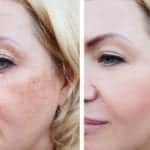

You know your skin better than anyone. But even when you take great pains to protect it from the sun, you need to be vigilant about and attentive to any irregularities that show up. Moles appear on all of us, and we can get lots of them throughout our lives.
Though most are benign and not a threat to your health, keep your eye on them, especially when you notice new ones or changes in pre-existing moles.
What types of moles should I be concerned about?
Moles form when pigmented skin cells grow in a cluster instead of being dispersed throughout the dermis. Sometimes they are skin-colored or clear and can even have hairs growing from them. They can change color or size over time.
A widely accepted way to assess the danger a mole poses is known as the “ABCDE’s” of moles:
- Asymmetry: When you look at the mole, would it be a mirror image of itself if you split it in half down the middle? A circular mole is usually a benign mole, but something that is misshapen should be seen by a doctor.
- Borders: If the outer edge of the mole is smooth, it is likely benign. But irregular textures or curves on the border can possibly be of concern.
- Color: When moles are a single color throughout, they’re probably nothing to worry about. Different shades and striations in a mole can raise concerns. If black or red coloring appears next to brown, a doctor should assess it.
- Diameter: The size of a mole can be important. Benign moles are usually small, but not always, and melanomas can grow beyond the size of a pencil eraser.
- Evolution: It’s not just size that you should keep track of. Change in color, texture, or even sensation in any moles can be the sign of a developing melanoma.
Don’t take chances if any new symptoms become apparent!
Some dermatologists use the “ugly duckling technique” to identify potentially threatening skin lesions. If one seems different from the others, with or without ABCDE signs, see a doctor.
How often should you have your skin checked?
It’s quite easy to do a simple once-over on yourself every few months – follow the ABCDE guidelines above.
I highly recommend an annual melanoma and skin cancer screening with a dermatologist if your skin surface is covered with many moles. If there’s any history of melanoma in your family, be extra vigilant and start getting regular checkups in your 20s.
What is included in a comprehensive skin check visit?
A comprehensive skin check should consist of an exam from the top of your scalp to the webs between your toes – and everything in between. It will take between 15 and 30 minutes, maybe a bit longer if biopsies need to be done.
Prevention of skin cancer is key – and DNA repair enzymes can help
Prevention is key, but for skin that has already been exposed to the sun, there are some other options to reduce the risk of non-melanoma skin cancers and pre-cancers.
DNA repair enzymes have been proven to be effective by reversing some of the DNA damage in skin cells that have received sun exposure. The body has natural enzymes that can help fight damage from the sun, but for many of us, we need more than we have naturally.
Repair enzymes can be spread over damaged areas to reduce the risk of pre-cancers and sun damage. They can also work some DNA magic by reversing your body’s tendency to produce free radicals, which cause detrimental changes to the skin.
Schedule an exam today – better late than never
Don’t feel guilty if you haven’t had a comprehensive skin check in a few years – or even never. Make an appointment today!
Posted In: Skin Care
Related Posts

November 27, 2025
Does Sunscreen Prevent Tanning? The Truth About UVA Rays
I often meet patients who sit across from me in the exam room, proudly telling me they've been diligent about wearing su...

August 11, 2025
Menopause Skin Changes: What You Can Do About It
As your hormones shift during perimenopause and menopause, your skin often tells the story before anything else. That gl...

May 30, 2025
Bust the Myth: Do Retinoids Cause Cancer?
Retinoids are one of the most powerful and widely used tools in modern dermatology, yet despite their many benefits, som...


